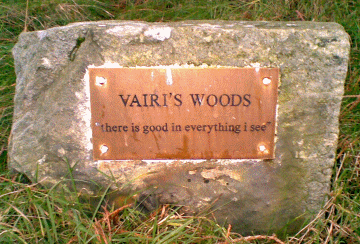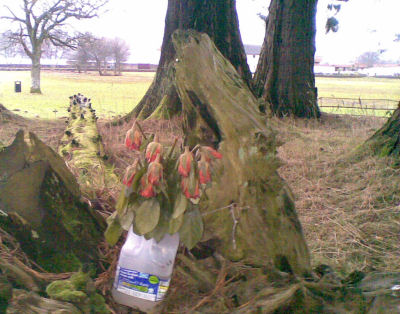Discussion Pages from 2010
On these pages we will post comments and information that we receive from you about the Vale or anything included in the website. Links to previous year's discussions are at the bottom of the page.
Please note that this is not a forum and it is not intended to be updated on a daily basis but if you have any points to make, anecdotes or stories about the Vale we would very much welcome your contributions. EMAIL them to us and we will publish them here.
(Most recent first)
13 September 2010
My family & I had to move from Clydebank in 1979 where our business was in a basement under tenements which were due for demolition. Clydebank council had no-where suitable to offer us. We originally bought a company called Jaclaw products which was on Glasgow road at the junction with Hume Street.
We changed the name to Taylor Products, then when we moved we became Taylor Products Ltd. Clydebank's short sighted loss, Bonhill gain. We had 4 part time workers & the family in Clydebank, but shortly after the move to Dalmonach Works, we had 8 full time workers + the family. We rented the majority of the premises of P Caulfield, which in the past, we believe had been barracks during WWII. We demolished all the non load bearing walls in the lower floor which then became a reasonable factory space of about 2,000. We remained there for about 3 years, & as our finished products took up a lot of volume, the space became restrictive & we bought an 11,000 Sq. Ft. asbestos building from Robert Pollock Junior which at one time had been a United Glass store.
Our production soared & at one time we had 21 staff on a three shift system. However, with the capital outlay, a decline in the shipyards & a recession in the whisky trade which we were heavily involved in, left us short of work & capital. We struggled on until 1985 with the Family doing the bulk of work for no more than living expenses, when we went into Voluntary Liquidation.
I hope this has been of interest to you & it helps to fill in some gaps in Dalmonach history.
Tom Taylor.
(Former MD of Taylor Products Ltd)teetee817 at talktalk dot net
14 July 2010
I was recently reminded of a (probably apocryphal) story related to the Scottish National football team's strip. Scotland played England in the first ever official international football fixture at West of Scotland Cricket ground in Partick's Hamilton Crescent. It is said that the international team did not have their own strip at this time and that they borrowed strips from Vale of Leven FC. That is why the Scotland team to this day plays in the same strip as the Vale, i.e. dark blue jerseys, white shorts and red stockings.
THE FACTS
Actually the Vale played their first game on 21 December 1872. Wikipedia states that the first International took place between Scotland and England three weeks earlier on 30 November 1872. All of Scotland’s players came from Queen’s Park FC so it is more likely that they would have used their own strips.Having said that, it may be that the Vale had already purchased their new strips and the national team may have preferred them but while it would be nice to know this happened I think it is unlikely. We’ll keep an ear to the ground but it is unlikely that this will ever be confirmed one way or another.
We would be glad to hear your comments on this and if anyone can add to this story please get in touch.
Update 14 July 2010
Graham Lappin was kind enough to send us this report on the match, which mentions the strip. The report appeared in the Scotsman Newspaper on December 2nd 1872.
"Football.
International (Association) Match,
England v. ScotlandThis match came off on the West of Scotland ground, Glasgow, on Saturday, in presence of the largest assemblage seen at any football match in Scotland there being close on 4000 spectators, including a good number of ladies.
For the first time since its inauguration has the match really earned for itself the title of International, both teams being bona fide players in each country, and the wisdom of the committee of the association in deciding to play the match in Scotland was shown by its great success, judged either by the play or the attendance.
The day was dull though dry, but the rain of the previous night had made the ground somewhat soft. The English team, even with the changes made in it, was very strong, the eleven comprising representatives from nine of the crack clubs of England. Their play all through, especially forward, was very much admired, Ottaway, the English captain, standing conspicuous, and astonishing the spectators by some very pretty "dribbling." During the first half of the game the English team did not work so well together, but in the second half they left nothing to be desired in this respect.
The Scotch (sic) team, on the other hand, though not comprising so many brilliant players, worked from first to last well together, through knowing each other's play. The match, after an hour and half's play ended in a draw, Scotland having the best of it in the first halt of the game, and England in the second.
The English uniform consisted of white jerseys, with the arms of England as a badge, dark blue caps, and white trousers and knickerbockers. Dark blue jerseys, with the Scottish lion for a badge, white knickerbockers, blue and white striped stockings, and red cowls completed the Scottish uniform."
25 March 2010
I would like to sincerely thank you and Graham Lappin in particular for including William Harriston’s poems on your web site.
I am a descendant of William Harriston and Margaret McGregor’s son, William. I was told about your web site today by another of their descendants.
To be able to read the poems written by my ancestor so long ago is simply wonderful. You have enabled me to put substance to another part of my family history story. I am very grateful.
Scotland has a right to be proud of its heritage.
William and Margaret Harriston’s son, James was the first person in the world to design a commercially viable ice making machine. He is now recognized as the world’s father of refrigeration. He did this in Geelong, Australia in the 1850’s.
Many thanks
Vicki Chin
Canberra, Australia
11 January 2010
A friend asked me if I knew anything about a (memorial?) stone that had been placed in the field opposite Duck Bay on Loch Lomond. His wife (Hazel Mills) had noticed this when walking her dog.
It is located in the middle of a copse of tall pine like trees (perhaps some sort of redwoods?), which have obviously been planted for a purpose. These are soft bark trees also found in Balloch Park. Some of you will remember them as the "punching trees" because the bark is so soft that you can punch it.
They form a circle which was once fenced but now open. The stone has a brass plaque engraved "Vairi's Woods". It also has the inscription, "There is good in everything I see".
We would be glad to hear from anyone who can provide any information on this stone.
Contact us >Bryan Weir
---------------------------------
11 January 2010
Bryan, perhaps ABBA copied it from an original source but the inscription is from an ABBA song "I have a dream" but other than that I have no re-collection of the woods, cheers, Ian Livsey
(Actually this is pretty close but the words of the ABBA song were actually "something good in everything I see". Bryan Weir)
-----------------------------------
27 January 2010
No further information about this yet. I was passing the site today while out walking and I noticed that there was a plastic container with a bunch of red roses sitting beside the stone.
There seems to be some misunderstanding of the location of Vairi's Woods. This is in the picnic field adjacent to the Duck Bay Marina, which can be seen in the top right background of the above picture.
Bryan Weir.
Archived Discussions 2008 | 2009 | 2010 | 2011 | 2012 | 2013




